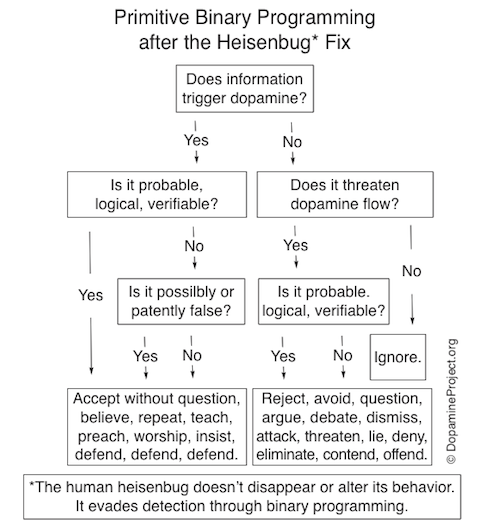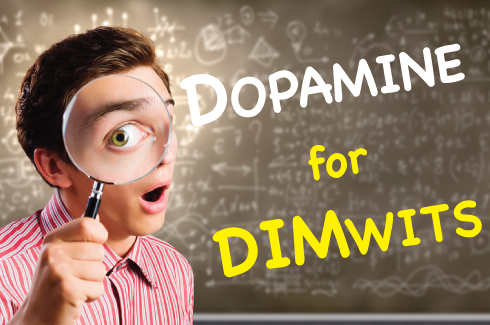None so blind…
“The first principle is that you must not fool yourself and you are the easiest person to fool.” – Richard P. Feynman
If you can’t, or are afraid to, understand how the human heisenbug fix turned our ancestors into DIMwits (with an infinite capacity to fool themselves) little of what you’re about to read will make sense.
Fortunately, it’s possible to fix the fix. Unfortunately, few are able to take the first step, which is to learn how the human heisenbug fix can and will keep you from taking the first step.
When good coding goes bad
“What makes you think that human beings are sentient and aware? There’s no evidence for it. Human beings never think for themselves, they find it too uncomfortable. For the most part, members of our species simply repeat what they are told – and become upset if they are exposed to any different view.”
– Michael Crichton, The Lost World
We’re here because primitive binary programming, dopamine-induced addictions, and natural selection created increasingly complex gene vehicles, biologically driven to transfer tested programming into future generations.
Long before humans debuted, evolution streamlined primitive programming to near perfection by honing dopamine maintenance (i.e. triggering and protecting dopamine flow) into a no-brainer for simple minds. The resulting binary coding ensured the survival of countless species by whittling all choices to two: dopamine appealing (yes/like/crave/seek/go) or dopamine repellent (no/hate/dread/avoid/stop).
The human heisenbug
In computer programming jargon, a heisenbug is a software bug that seems to disappear or alter its behavior when one attempts to study it. – wikipedia.org
From the start, the code included a dormant flaw capable of morphing into a serious bug. But not for pre-primates. Millions of years later, the same basic programming continues to function flawlessly with lower animals. The key word is basic, because the programming is limited to elementary withdrawals (aka fears, hungers, thirsts, and lusts) complementing basic addictions to retreating, refueling, rehydrating, and replicating.
[In a future chapter I cover why DIMwits find it so difficult to grasp, acknowledge, admit to, and/or agree about the definition of addictions.]
The heisenbug grew increasingly (though only potentially) problematic when complicated social instructions were patched onto basic code. As chimpanzees demonstrate, apes programmed to crave acceptance, approval, and status (while dreading rejection, disapproval, and ridicule) are likelier to bequeath strategic social addictions than independent asocial peers.
Despite striking similarities with humans, a critical distinction protected our simian relations from the heisenbug corrupting human programming.
Dopamine dissonance
“To every man is given the key to the gates of heaven. The same key opens the gates of hell.” -Richard Feynman
The aggregate coding, extended to foster the survival of intellectually limited apes, started faulting with our intellectually gifted prototypes. As human consciousness evolved, the permutation of new awareness and old heisenbug pitted heretofore compatible programming against itself, turning a blessing into a curse.
We know what early humans wanted because we inherited their genetic coding. Like chimpanzees, they were programmed to crave the dopamine triggered by expectations of maximizing safety, acceptance, approval, and status. Unlike chimpanzees, our forebears’ programming featured a nascent intelligence.
Cognizance proved to be a double-edged sword. The upside included titillating opportunities to fabricate seductive, addictive, esteem-elevating deceptions about being exalted humans, superior to inferior animals and closer to imagined gods. The downside left growing numbers of sapient primates grappling with an esteem-deflating awareness of what they actually were – lying, cheating, vindictive, urinating, defecating, lustful, smelly, homicidal, inhumane, horny, scared, delusional, colluding, conniving, opportunistic, superstitious brutes.
The heisenbug made it impossible to resolve unresolvable conflicts between mutually exclusive dopamine-appealing deceptions (to feed cravings for significance) and dopamine-repellent conceptions (of insignificance).
In other words, binary code designed to run crave OR dread was stymied by crave AND dread.
Something had to give.
Luckily for us, gene vehicles don’t crash the way computers do. They adapt. Which is what our ancestors did and why you’re reading this.
The heisenbug fix
“The most exciting phrase to hear in science, the one that heralds new discoveries, is not ‘Eureka!’ (I found it!) but ‘That’s funny…’”
– Isaac Asimov
I believe the adaptation involved going insane and, because of the ubiquitous hiesenbug, similar programming revisions occurred in disparate and dispersed groups around the world. Meanwhile, those that didn’t go mad were eliminated by marauding, malevolent, murderous gangs that did.
The conflicts were resolved by a clever slight of mind. The trick was a tweak in the primitive coding that made certain thoughts so dopamine repellent they became too neurologically painful to think. Especially when it came to thoughts that included the threat of ridicule and rejection from peers who found those thoughts too painful to consider.
In effect, insanity provided a workable fix by blocking a short list of esteem-threatening ideas, concepts, and speculations while allowing a long list of developing, intellectual, technological, creative, productive, and destructive capacities. Which is why rocket scientists can do the math to reach the moon yet can’t put two and two together to figure out how a neurotransmitter rendered even the best and brightest among them non compos mentis.
 What is in a name
What is in a name
“If one looks with a cold eye at the mess man has made of history, it is difficult to avoid the conclusion that he has been afflicted by some built-in mental disorder which drives him towards self-destruction.” – Arthur Koestler
Until scientists catch up, verify, and rename the adaptation, I’m calling it dopamine-induced madness (DIM). DIM succeeded by devolving potential humans, who couldn’t run contradictory coding, into malfunctioning DIMwits who could and do.
There’s no way of knowing if DIM was an evolutionary miscalculation (in the process of correcting itself), if our gene donors were somehow afflicted with the disorder, or if the madness was introduced by opportunistic mutations who benefitted from faulty programming. Regardless of origin, DIM proved to be a sloppy but effective patch for creatures programmed to avoid threats to dopamine flow. Insanity prevailed by delivering a dopamine bonanza that made it possible for inhumane apes to get away with indulging, ignoring, and denying primal addictions while inflating esteem with flimsy delusions about being high-minded, moral, rational, sane Homo sapiens sapiens.
Moreover, DIM made (and makes) it easy for seemingly intelligent DIMwits to ignore, overlook, deny, accept, and justify the most glaring symptoms of addictions and insanity. Because acknowledging symptoms includes the dopamine-repellent risk of exposing the source, something DIMwit programming effectively blocks.
Together, dopamine-induced madness plus addictions added up to the perfect pandemic. Comorbid brain disorders capable of keeping sufferers from wanting to know our species is afflicted with debilitating brain disorders that make maintaining dopamine flow in primitive brains more important than saving our species from self-destructing.
Let me repeat that. Our species is afflicted with debilitating brain disorders that make maintaining dopamine flow in primitive brains more important than saving our species from self-destructing.
Means and ends
“In discarding the monkey and substituting man, our Father in Heaven did the monkey an undeserved injustice.” – Mark Twain
With chimpanzees, life-sustaining dopamine-induced addictions (to food, safety, power, acceptance, approval, attention, and status) evolved because they were means to one, logical, obsessive end = orgasm = ultimate dopamine prize = ultimate addiction.
As clever DIMwits grew more and more enamored with dopamine they began hacking into the delicate dopaminergic system by triggering the powerful neurotransmitter with drugs, gambling, belief systems, status symbols, and money. In doing so, not-very-bright hackers reprogrammed proven biological means into bio-illogical dead-ends unto themselves.
Dopamine is so potent that artificially flooding the system destroys fragile sensors, creating an addictive cycle where too much dopamine can never be enough. So instead of supporting survival, addictions (to food, safety, power, acceptance, esteem, and sex) cause obesity, strife, conflicts, conquests, crusades, jihads, waste, pollution, destruction, unwanted children, STDs, sickness, and death.
Dopamine-induced madness and addictions are complimentary co-occurring diseases because the former provides the deceptions and denials required by the latter.
Today, the same DIM helping drug addicts deny reprehensible behaviors makes it possible for addiction experts to deny the existence of common addictions (to safety, power, acceptance, status, and/or money) that keep them scrambling for degrees, titles, positions, and significance.
Meanwhile, the heisenbug fix culminated in a disastrous dopamine glitch that derailed human evolution and produced DIMwits who don’t want to know why they don’t want to know about the widespread, obvious, and maddening insanity.
Our situation continues to be especially problematic because the scientific community is dominated by DIMwits who invested years essentially proving peer-approval addiction not only exists, it’s a prerequisite for admittance to a private club that considers itself the arbiter of scientific truth. No surprise, the members of a profession that should be discovering and exposing dopamine-induced madness are highly unlikely to risk ridicule, rejection, exclusion, along with the loss of jobs, funding, and esteem as repayment for outing themselves and colleagues for what they actually are – peer-approval addicts unconsciously committed to remaining conveniently ignorant of, and covering for, a brain disorder instead of using their brains and equipment to establish the disease’s existence.





Discussion
Comments are closed.